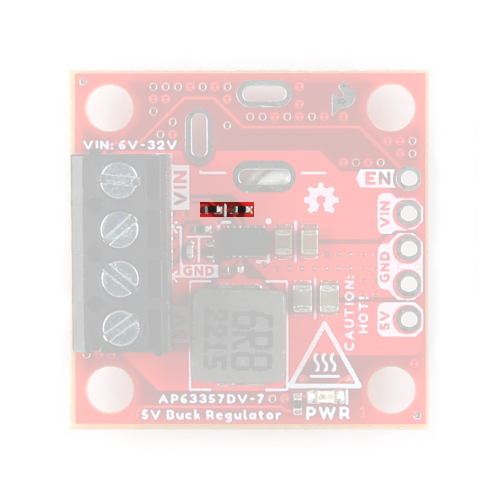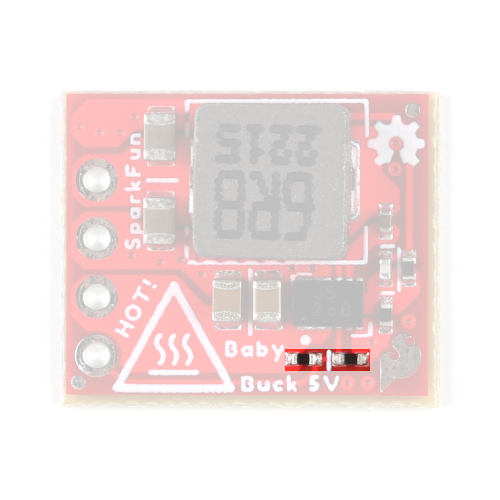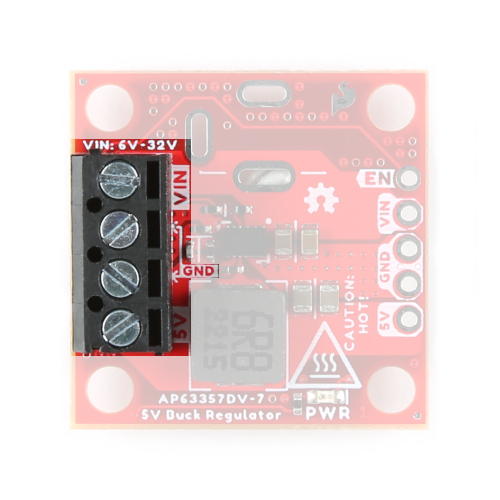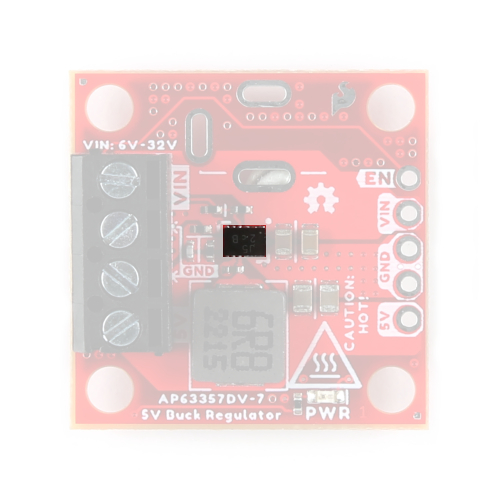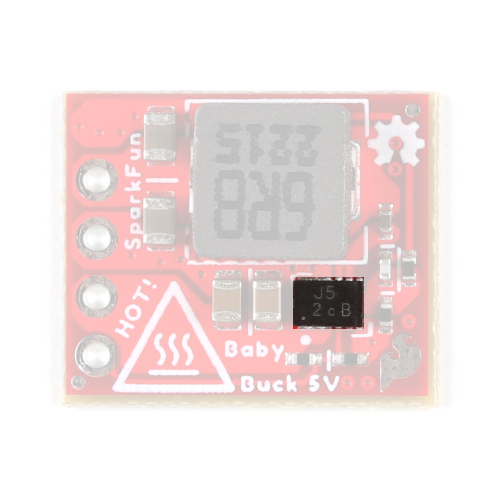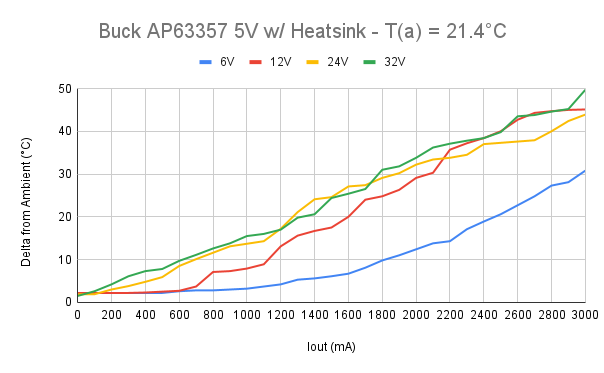Hardware Overview
Danger: These boards can get extremely HOT
Please handle these boards with the utmost caution. Users can easily burn themselves when the board outputs anything over 2A.
Board Dimensions
The board dimensions are illustrated in the drawing below; the listed measurements are in inches.
Board dimensions (PDF) for the 5V buck regulator breakouts (AP63357), in inches.
Need more measurements?
For more information about the board's dimensions, users can download the eagle files for the board. These files can be opened in Eagle and additional measurements can be made with the dimensions tool.
Eagle - Free Download!
Eagle is a CAD program for electronics that is free to use for hobbyists and students. However, it does require an account registration to utilize the software.
 Dimensions Tool
Dimensions Tool
This video from Autodesk demonstrates how to utilize the dimensions tool in Eagle, to include additional measurements:

Power
Users are provided with PTH to connect their external power supply, the output voltage from the board, and the EN power control pin for the buck regulator. The AP63357 buck regulator has an input voltage range is 3.8V to 32V. However, the boards require a 6V minimum power supply to operate; as it is a step-down DC/DC converter with a 5V output. (i.e. The boards cannot step-up or boost the voltage output.)
 The PTH power pins on the 5V Buck Regulator (AP63357DV). |
 The PTH power pins on the 5V Baby Buck Regulator (AP63357DV), viewed from the bottom. |
Below, is a general summary of the circuitry on the board:
VIN- Power supply input (6V to 32V)- The undervoltage lockout will engage intermittently if the input voltage is below 6V.
EN- Enables the power output of the board- Has an input voltage range up to 32V
- Must be pulled
HIGHabove 1.18V to enable the power output.
5V- Regulated 5V output (up to 3.5A)GND- The common ground or the 0V reference for the board
Info
For more details, users can reference the schematic and the datasheets of the individual components in the power circuitry.
Limitations - Load Current
- While the IC is rated up to 3.5A, users may experience thermal limitations towards that maximum.
- Users should reasonably expect to be able to place a maximum 3A load on the boards when using a heat sink and active cooling (i.e. fan).
- At the peak load of 3.5A, users will need sufficient cooling to prevent the IC's thermal shutdown
- With a heat sink, we have found users can expect to draw up to 2.5A
- Without a heat sink or active cooling, we recommend users not load the boards with more than 1.5A.
Quiescent Current Draw
Users should expect a maximum quiescent current draw of ~365µA from the board due to the voltage divider for the UVLO. For a lower quiescent current, users can modify the board by removing the voltage divider's resistors.
-
Measured Values
Input Voltage (V) Iq (µA) Iq - Power Enabled (µA) 6 65 196 12 129 209 24 260 290.5 32 330 355 Info
For more information about the measured values for the quiescent current, please refer to this GitHub issue.
-
Danger
Modifying a board to remove the voltage divider, requires advanced soldering skills. Users should not attempt this modification unless it is absolutely, necessary and they are confident in their skills because the board can be permanently damaged.
Alternative Connections
Buck Regulator (only)
The following features are only available on the Buck Regulator and are not available on BabyBuck Regulator.
PTH (slots) are provided for users to add a barrel jack connector to the top or bottom of the board. This provides users with an alternative method to connect a power supply to their board.
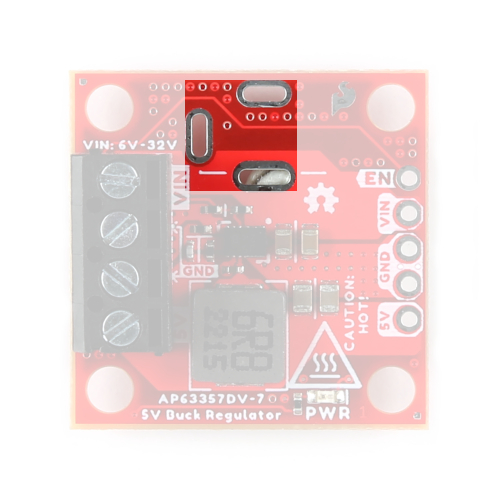
Power LED
The red, power (PWR) LED will light up when the switching power output is enabled. (Not available on baby buck regulator board.)
The PWR status LED indicator for the 5V Buck Regulator (AP63357DV).
Power Control
There is a high-voltage enable pin (EN) to control the output voltage (i.e. on/off), with a typical threshold voltage of 1.18V and a range up to 32V
- Users should pull the
ENpin high (above 1.18V) to enable the switching power output and pull the pin low to disable it. - As a high-voltage pin, users can also connect the
ENpin toVINto automatically start up the device. - Users can also configure the
ENpin to set the UVLO threshold.
Default Configuration
On our boards, the EN pin is used to set the UVLO threshold. Therefore, the power output from the board is enabled by default.
 Enable pin on the 5V Buck Regulator (AP63357DV). |
 Enable pin on the 5V Baby Buck Regulator (AP63357DV), viewed from the bottom. |
AP63357
The AP63357 from Diodes Incorporated, is a 3.5A, synchronous buck converter with a wide input voltage range of 3.8V to 32V. The device fully integrates a 74mΩ high-side power MOSFET and a 40mΩ low-side power MOSFET to provide high-efficiency step-down DC-DC conversion. When operating in PFM during light load conditions, the AP63357 can achieve a power efficiency of up to 86% with a 5mA load. Additionally, under a no-load, non-switching condition, the quiescent current is typically 22µA; and when disabled, the device shutdown supply current is only 1μA.
The AP63357 features a high-voltage EN pin that can be directly connected to VIN to automatically start up the device. To prevent output voltage overshoot and inrush current, the AP63357 also has a built-in 4ms soft-start time. Users can also configure the EN pin to set the undervoltage lockout threshold.
Power Efficiency
Users should expect a power efficiency close to the charts presented in Figures 3, 25, and 26 in the datasheet (i.e. 70% with smaller loads and up to 95% with larger loads). While the efficiency varies with the load current and cooling, we didn't see anything below 85% for most of our test cases.
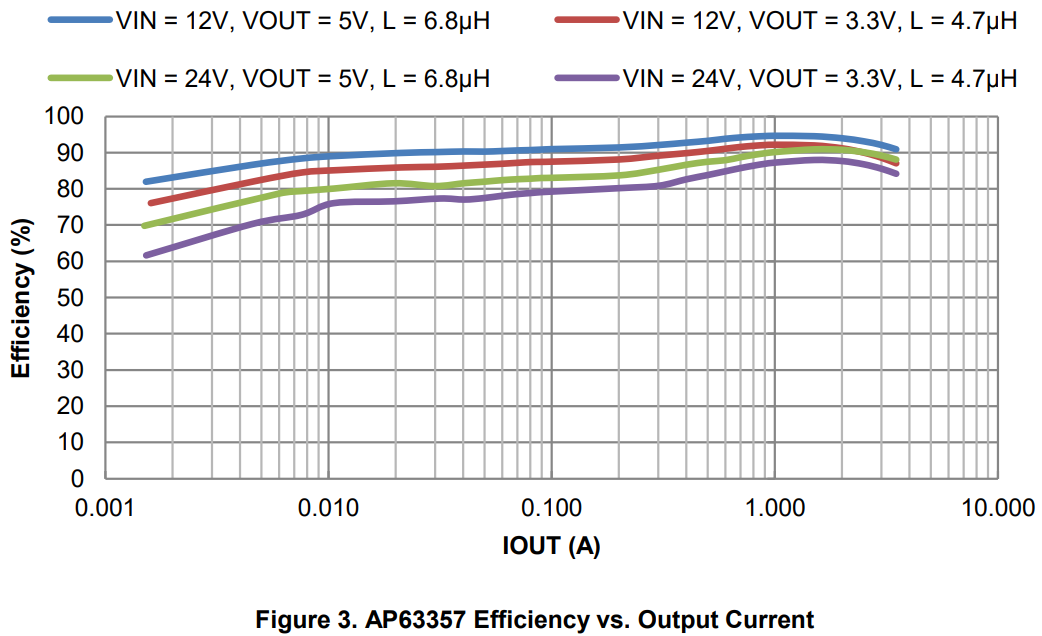
Line and Load Regulation
Users should expect a line and load regulation close to the charts presented in Figures 27 and 28 in the datasheet (i.e. 5.0 ±0.2V). While these vary with the load current and cooling, we didn't see an output voltage below 5V in our tests.
Additionally, we will note that there is some noise in the output voltage, due to the switching of the regulator. While this increases with the load current, for most users it won't be relevant to their use case.
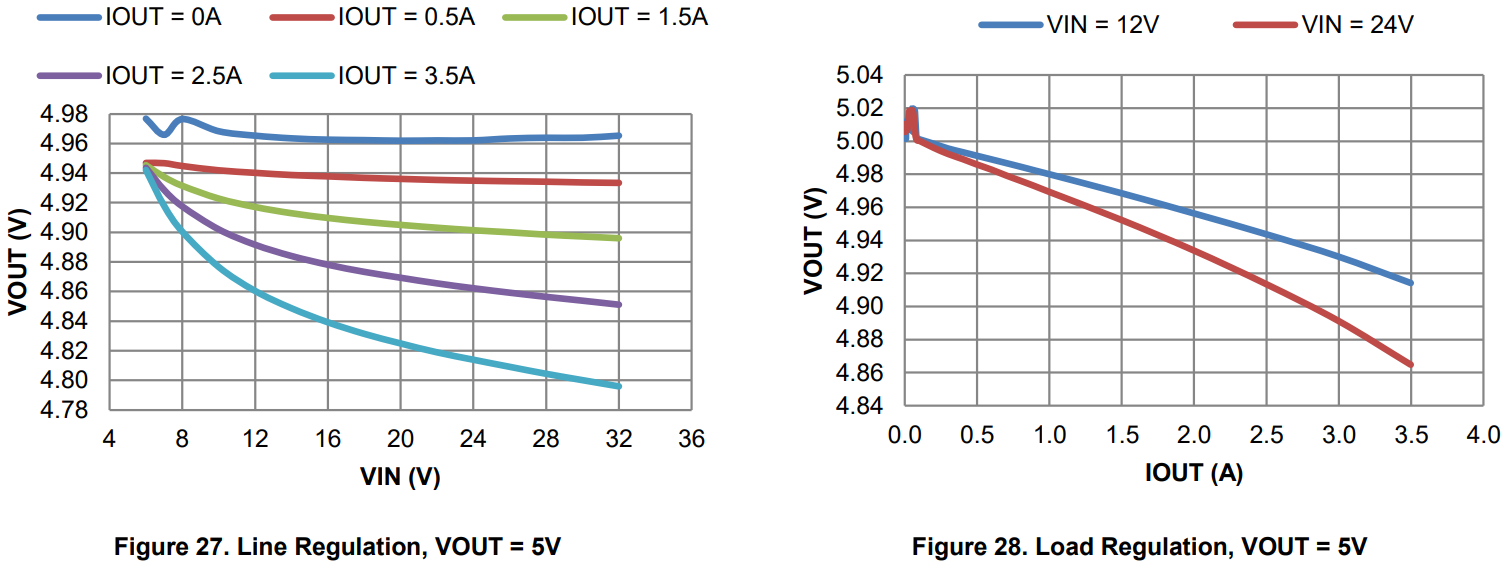
Undervoltage Lockout
An undervoltage lockout is implemented to prevent the IC from insufficient input voltages. The AP63357 device has a UVLO comparator that monitors the input voltage and disables it when the input voltage falls below 3.08V. Some applications may desire higher VIN UVLO threshold voltages than is provided by the default setup. A pull-up current source on the EN pin, along with an external resistive divider (R3 and R4) configure the VIN UVLO threshold voltage, as shown in Figure 37 of section 5 - Adjusting Undervoltage Lockout (UVLO) of the datasheet.
The resistive divider's resistor values are calculated by:
Where:
(1) VON is the rising edge VIN voltage to enable the regulator and is greater than 3.6V
(2) VOFF is the falling edge VIN voltage to disable the regulator and is greater than 3.18V
- Configured at 5.6V
- Configured at 5.18V
Tip
While the undervoltage lockout is configured for 5.6V on the high end, users should provide at least 6V for the input voltage. Based on testing, we found 6V to be a more realistic expectation to avoid an undervoltage lockout from the boards.
Heat Sink Pad
Danger: These boards can get extremely HOT
Please handle these boards with the utmost caution. Users can easily burn themselves when the board outputs anything over 2A.
A platted copper pad is provided on the back of the boards, where users can add a heat sink to dissipate excess heat generated by the AP63357. While the pad size is slightly different between each board, they both can accommodate the copper heatsink in our catalog.
- Buck: 0.5" x 0.6"
- BabyBuck: 0.435" x 0.5"
 Heat sink pad on the back of the 5V Buck Regulator (AP63357DV). |
 Heat sink pad on the back of the 5V Baby Buck Regulator (AP63357DV). |
Thermal Characteristics
Thermal Shutdown Temperature
The AP63357 has a 170°C (338°F) thermal shutdown temperature.
The thermal limitations of the board will dictate the maximum load current our boards can provide. Below is a chart of some testing we have performed using the full-size, 5V Baby Buck Regulator with a heat sink attached to the back of the board.
Thermal characteristics for the 5V Baby Buck Regulator with a heat sink.
Info
For more information on the thermal characteristics of the AP63357, please refer to the datasheet.
Thermal Limitations on Load Current
- Without a heat sink or active cooling, we recommend users not load the boards with more than 1.5A.
- With a heat sink, we have found users can expect to draw up to 2.5A
- While the IC is rated up to 3.5A, users may experience thermal limitations towards that maximum.
- Users should reasonably expect to be able to place a maximum 3A load on the boards when using a heat sink and active cooling (i.e. fan).
- At the peak load of 3.5A, users will need sufficient cooling to prevent the IC's thermal shutdown.
Jumper
Never modified a jumper before?
Check out our Jumper Pads and PCB Traces tutorial for a quick introduction!
There is a jumper on the back of the board that can be used to easily modify a hardware connection on the board. (Not available on baby buck regulator board.)
- PWR - This jumper can be used to remove power to the
PWRLED.
The LED jumper on the back of the 5V Buck Regulator (AP63357DV).

